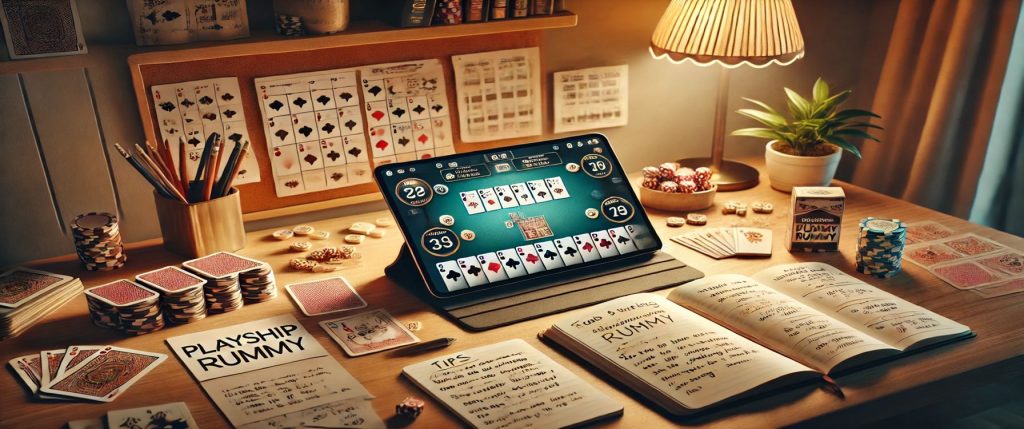
Playship Rummy is an engaging card game that blends strategy, skill, & a little bit of luck. Learn how to play it with this comprehensive guide. It can be played by two to six people & is a flexible option for parties because it uses a standard deck of cards. In order to “go out”—that is, to merge all of your cards before your opponents do—the player must first form sets and runs of cards.
Both new and experienced players must grasp the fundamentals of Playship Rummy. Each player is dealt a certain number of cards at the start of the game, and the remaining cards are arranged in a draw pile. Each player draws from the draw pile or the discard pile, and then they each discard one card.
Choosing how to construct their hands, control their discards, & predict the moves of their opponents are all strategic decisions. The fundamental ideas of melding & laying down cards are at the heart of Playship Rummy. Grouping cards into valid runs (three or more consecutive cards of the same suit) or sets (three or four cards of the same rank) is known as melting. The game encourages players to think critically about their hands and the potential combinations they can create.
Because it can reveal important information about their tactics, players must keep an eye on what their opponents are gathering as they draw and discard cards. Because every turn in Playship Rummy offers fresh possibilities and difficulties, the game’s dynamic nature keeps players interested. By understanding these fundamentals, players can start creating their own strategies & increase their winning chances. In Playship Rummy, developing a strong hand necessitates a blend of strategic planning, flexibility, and card combination knowledge.
Prioritizing the creation of runs and sets early in the game is one successful strategy. This entails being mindful of the cards you draw and eliminating any that don’t support your overarching plan. For example, if a suit contains multiple cards, draw more cards from that suit first in order to finish your run. To prevent your hand from becoming cluttered, think about throwing away cards that don’t fit into any possible melds as soon as possible. Maintaining a record of the cards that have been played or discarded is another crucial piece of advice for creating a strong hand.
With this knowledge, you can determine which cards are still in play and which ones your opponents are most likely to draw. You can decide which cards to pursue and which to let go of by paying attention to their discards and melds. Think about the possibility of keeping high-point cards until you are almost ready to leave.
By using this tactic, you can increase your score as much as possible while lowering the possibility of giving your opponents an advantage. One crucial component of Playship Rummy that can have a big impact on your overall performance in the game is discarding cards sensibly. Avoiding discarding cards that might help your opponents is a basic tactic. For instance, exercise caution when discarding cards that fit into your opponent’s possible melds if you observe that they are collecting a particular suit or rank. In order to keep your own hand manageable, concentrate on discarding cards that are less likely to be helpful to others. The ability to keep your hand flexible is another useful discarding technique.
This entails having the flexibility to modify your plan of action in response to the cards you draw and the moves your opponents make. Consider turning your attention to another possible combination if you find that a certain meld is getting harder and harder to finish. You can keep your hand under control and improve your chances of winning by discarding cards that are no longer useful to you while leaving options available for subsequent turns. The core of Playship Rummy is melting, and becoming an expert at it can help you stand out from the other players. Effective melding requires a thorough comprehension of the various card combinations that can be created.
Every turn should begin with an evaluation of your hand to determine possible sets & runs. Prioritize combining the combinations that will enable you to exit swiftly while also taking into account how they might impact the tactics of your rivals. When it comes to blending, timing is also very important. Although it might be tempting to lay down every meld you have as quickly as possible, doing so could give your opponents too much information about your hand. Rather, think about delaying some melds until you are closer to leaving or until you can surprise your opponents.
This calculated withholding can keep them guessing about your true intentions while giving you the chance to profit from their errors. Jokers and wild cards are effective tools in Playship Rummy that can greatly improve your gameplay. These adaptable cards are great tools for creating a strong hand because they can be used to form sets or runs in place of any other card. Think about how to use your joker or wild card to get the most out of it.
For instance, strategically employing a wild card can assist you in completing multiple combinations at once if you have multiple cards that could form different melds. But it’s also crucial to consider how you use wild cards and jokers in relation to your opponents’ hands. Using a joker to block an opponent’s possible melds can be a game-changer if you see that they are about to go out and have been gathering particular cards. Also, you may have more freedom to modify your strategy in response to changing table dynamics if you wait until later in the game to use wild cards.
As players get better at Playship Rummy, they frequently look for more sophisticated tactics to outplay their rivals. Bluffing, or purposefully discarding cards that could give opponents the wrong idea about your true intentions, is one such tactic. An opponent may think they should concentrate on that suit rather than realizing your true strategy if you discard a card from a suit that you are not actively pursuing, for instance. This psychological component gives the game a thrilling new dimension and may lead to unanticipated successes.
Having a good sense of when to go out is another sophisticated tactic. Even though it could seem beneficial to leave as soon as possible, waiting for the ideal opportunity can frequently produce better outcomes. Your opponents can tell when they are holding onto high-point cards or when they are almost finished with their melds by looking at their hands & discarding patterns. You can optimize your score and reduce the possibility of giving away points to others by carefully planning when to leave. Since it enables players to keep control of their strategies while adjusting to the moves of their opponents, effective hand management is essential in Playship Rummy.
Throughout the game, it’s important to keep an eye on the composition of your hand. Assessing which cards are necessary to finish melds and which ones might be better off being thrown away is part of this. You can make decisions more quickly at each turn if you keep your hand structured & concentrated on possible combinations.
Monitoring your opponent’s moves is just as crucial as controlling your own hand. Keep an eye on what they discard & meld during the game in addition to the cards they draw. This data can help you predict their next actions & offer insightful information about their tactics. You can increase your chances of winning & possibly foil your opponents’ strategies by remaining aware of the game’s flow and making well-informed decisions.
Adaptability, strategic thinking, and skillful play are all necessary for success in Playship Rummy. Finally, stay patient during the game; making snap decisions can result in errors that cost you important opportunities or points. Consider how your actions may affect both your hand & your opponents’ hands as you carefully examine each turn. And when it comes to learning Playship Rummy, practice makes perfect. Playing more will improve your ability to spot trends, create plans, and predict your opponents’ next moves.
Talking tactics and exchanging experiences with other players who are as interested in honing their skills as you are can give you new insights that improve your gameplay. Ultimately, you will be well on your way to becoming a formidable player in Playship Rummy if you combine these tips with commitment and practice. To sum up, Playship Rummy is a complex combination of skill and strategy that rewards careful play & astute observation rather than being merely a game of chance. Players can greatly increase their chances of winning this captivating card game by learning the fundamentals, creating strong hands, discarding sensibly, becoming proficient in melding strategies, making effective use of wild cards, implementing sophisticated tactics, managing hands effectively, and practicing frequently. Regardless of whether you’re playing informally with friends or competitively in more formal settings, these tips will improve your gameplay & make Playship Rummy more enjoyable overall.




